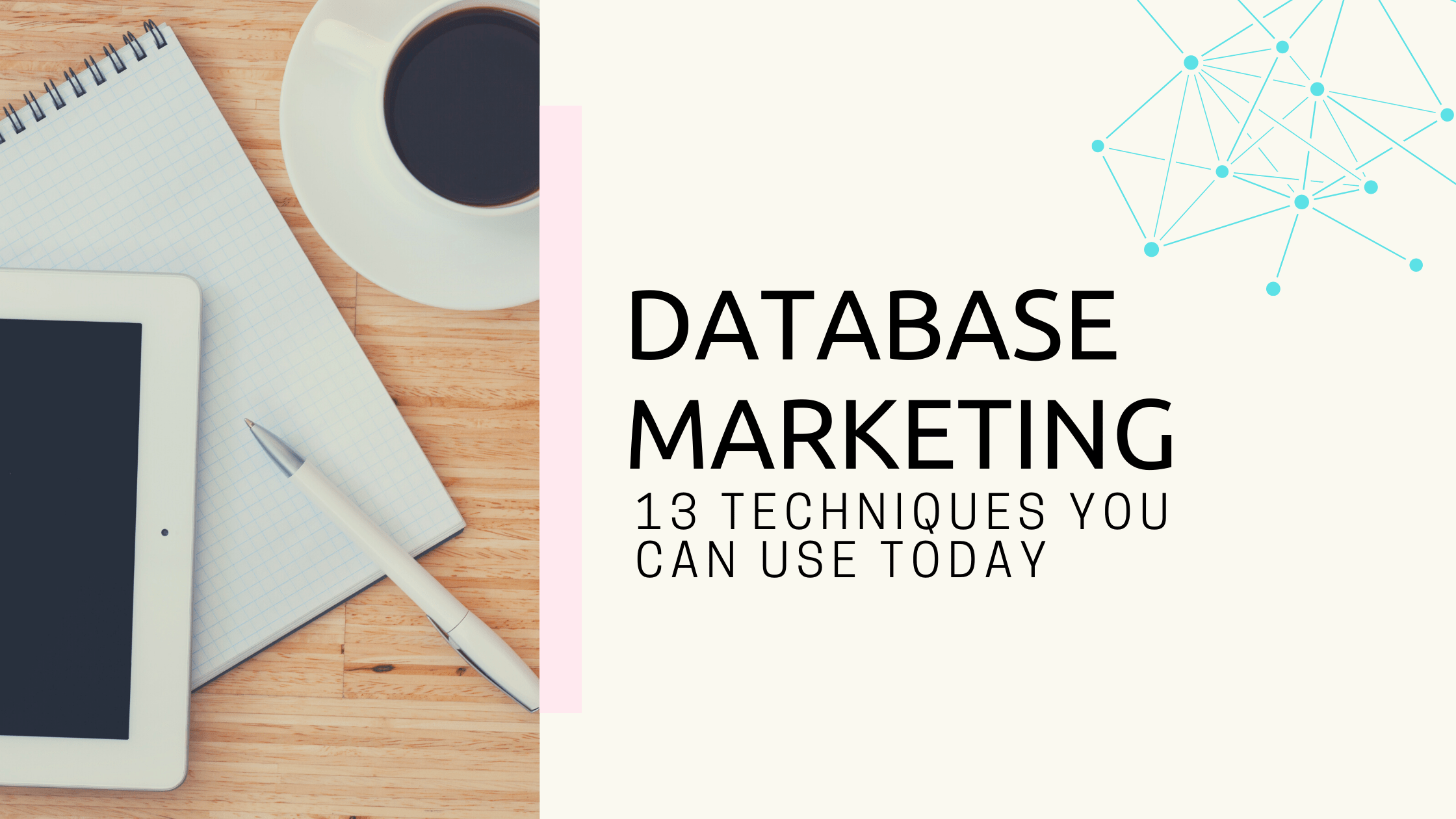What is Database Marketing?
Database marketing, also called customer relationship management, refers to the collection of your customers or potential customers’ data in order to understand their needs and offer personalized communications that address those needs. Simply put, database marketing involves understanding and managing your customer database.
![What Is Database Marketing? Why It's Important and How to Do It Right [Infographic] | CleverTap](https://d35fo82fjcw0y8.cloudfront.net/2018/09/05102935/Blog_header-e1551339439285.png)
A marketing database contains data elements such as name, email, phone number, job title, company revenue, purchase history, lifetime value, website cookies and so on.
Benefits of customer database marketing
Database marketing offers a number of benefits over traditional marketing.
The biggest improvements stem from the combination of deep customer databases and personalization software.
1. Improved Conversion Rates
Database marketing is centered on presenting relevant, compelling messages to the right customers. As a result, average conversion rates across the funnel, from open rates to sales increase.

2. Increase Average Order Value (AOV)
Through utilizing known customer preferences, product affinities, and past orders, companies can increase the AOV of each customer purchase.

3. Better Pricing Strategy
An often-overlooked capability database marketing unlocks is pricing strategy implementation.

4. Excellent Customer Service & Interactions
Because marketing communications are informed, customers only receive messages that are relevant to them. This is especially powerful when used in conjunction with after sales service and product extensions based on purchase of a specific SKU.

5. Higher Return on Marketing Investment (ROMI)
As a result of better conversions, higher purchase orders, and price optimization, database marketing results in a higher ROMI. This has a number of second order effects, from opening up more expensive marketing channels while maintaining profitability, to being able to provide better incentives to first time customers.

Challenges of Database Marketing
Database marketing offers some compelling benefits — but to do it successfully, marketers need to understand the challenges as well.
Watch out for these database marketing challenges:
6. Data decay
Anytime a customer or prospect changes jobs or earns a promotion, moves to a new address, changes their name, gets a new email address, or makes any other life change, their profile becomes out of date. A well-managed database decays at an average 2-3% each month, which means in just a year, a third of your data could be invalid.* To limit data decay, focus on information that is less likely to change: name and phone number, for example, rather than business email.
7. Data accuracy
Customers don’t always provide accurate information. Typos, handwriting legibility, or incomplete info can have a big impact on the quality of your database. You can limit inaccuracies by replacing input fields with standardized drop-down menus or checkboxes.
- Acting on customer data in a timely manner
Collecting and analyzing customer data is just the first step. You have to act quickly enough to capitalize on a customer’s interest in and interactions with your brand. This is where marketing automation tools like CleverTap become so important. By unifying rich user profiles with powerful segmentation and omnichannel marketing campaigns, you can deliver timely, personalized experiences for each and every user.
Effective Database Marketing Strategies
8. Identify your target audience
How old are they? What income level? What job title? Where do they live? What are they interested in? What else do they buy? Build a detailed ideal customer profile for your product, and then use this profile to decide what kind of information you need to include in your database.

9. Collaborate with other teams
Marketing, sales, and support all have direct contact with customers and prospects. What information does each team need to be effective?

10. Find the right software
Customer data doesn’t do anyone on your team any good if they can’t access it. Choose a tool that makes it easy to see different kinds of information, customer types, and even organize customer information to match your different product or service categories.

11. Gather customer data
Look to both internal and external data sources, including:
- Acquisition data
- Demographic data
- Technographic data
- Psychographic data
- Activity data
- Transaction data
- Correspondence data

12. Keep data up-to-date and backed up
Building a customer database takes a lot of time and effort. Protect your investment by safeguarding against power outages and technical glitches. CRM software can automatically update profiles when customers enter new information, and online tools can protect against data decay by integrating with your software and updating each contact as they browse your website with activity data.

13. Respect customer privacy
Social media makes it easier than ever to get detailed insights into your customers’ interests, perspectives, and life updates. Effective personalization is about providing a relevant message to an interested audience — not proving how much personal data you have.

After building your database, you can start with some basic user segmentation. For example, create a campaign specifically for first-time buyers or new customers, or one tailored for your loyalty program participants.
READ MORE:
Loyalty Pays. Customer Loyalty: What it is and What Really matters
LET’S GET TO THE GOOD STUFF!
Here are my favourite Database marketing tactics
- 2. and 3, Advanced Segmentation based on Recency, Frequency, Monetization (RFM) Marketing
RFM segmentation enables personalized marketing, increases engagement, and allows you to create specific, relevant offers to the right groups of customers. Further, it is one of the best ways to maximize cohort analysis to increase retention.
The idea is to segment customers based on when their last purchase was, how often they’ve purchased in the past, and how much they’ve spent overall. All three of these measures have proven to be effective predictors of a customer’s willingness to engage in marketing messages and offers.
4. Combine product and customer data to time replenishment campaigns
Customer database platforms give you the ability to record which customers bought which products. This information is incredibly useful for consumables.
5. Improve Customer Lifecycle through customer journey
Lifecycle marketing focuses on the broader customer journey. As customers engage with your brand, they go through “stages”.
While each business model is different, the most common stages in lifecycle marketing are:
- Customer Acquisition
- Customer Retention
- Customer Development/Loyalty
The third stage is where customers expand into other product lines or refer clients.
6. Omnichannel database marketing example strategy
Omnichannel marketing focuses on creating a coherent customer experience across marketing channels.
It relies heavily on a database that is capable of creating a single, 360 degree customer profile.
Brand channels are then able to reference past customer interactions on other platforms to optimize customer experiences.
7. Retention Marketing
Customer retention strategy describes the activities used to transform customers into repeat customers.
Repeat purchase, increased AOV, and an overall increase in LTV is often leveraged into expanding additional communication and acquisition channels.
8. Increase retargeting campaign potential with outreach campaigns
Regular outreach campaigns are crucial to re-engage your customer base and gather the data needed for triggered retention campaigns.
9. Optimize customer engagement with personalized channels
Customers have different habits. Some use Facebook. Others prefer Instagram. Some check their email. Others don’t.
Customer database marketing allows eCommerce stores to identify which channels prospects are most likely to engage with.
10. Schedule smartly
In my experience, I’ve seen better eCommerce sales attributed to edm sales shoot up to the roof on Monday and Tuesdays. For B2B, it’s Thursday. Avoid weekend.
11. Subscribe to WI-FM
What’s In It For Me? Be upfront with your customers on what they can expect – rewards, tiers, programs, or from the get-go when they enter their email. You’re doing both your database health and your customer are a favor.
12. Use behaviour insights
Serve content based on the intent where they last left off. One of the best tool I’ve used is ActiveCampaign (try their 14-day free trial now) which follows the behaviour and conversion intent of your website visitors – from visiting pricing page, to performing actions like brochure download.
11. Dynamic product
Advanced CRM like Mailchimp and Klaviyo does this pretty well. You can see this from automations like Cart Abandoned – note to only do this on checkout and not on browse.
Final Thoughts
With thousands of advertisers fighting for customers’ attention every day, the need for a database marketing strategy is critical. The businesses that place their customer’s needs, experiences and preferences will always come out on top.
